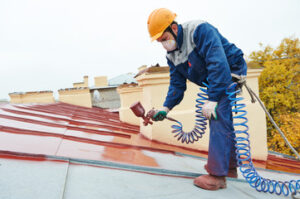Essentially, roof coating is an extra layer that protects the original roofing materials from harsh weather conditions and other factors that cause damage over time. Commercial Roof Coating also offers more insulating benefits.

Proper surface preparation and adherence to manufacturer guidelines help to maximize the lifespan of a roof coating system. Evaluate warranty coverage before making a purchase decision.
There are a few different factors that can influence how long a roof coating lasts, including the type of roofing material and the climate. However, on average, commercial roof coatings can last up to two decades. This length of time can help you avoid costly repairs or replacements while extending the lifespan of your roof.
The most important thing to remember is that a roof coating acts as an extra layer of protection for your existing roof. It creates a seal that can’t be penetrated by the elements that cause wear and tear, halting the aging process and giving your roof several more years of life.
Moreover, a roof coating helps your building save energy by reflecting sun rays and keeping the indoor temperature comfortable. It also prevents leaks by sealing out moisture and acting as a barrier to water infiltration. The lifespan of a commercial roof can be extended by coating it, allowing you to avoid costly replacements in the future.
In addition, a commercial roof coating can protect the surface from pollutants and biological growth, such as moss or algae, reducing the need for frequent chemical treatment or cleaning. A coated roof is less likely to deteriorate or become discolored, making it an attractive option for your business’s image and increasing the value of your property.
When it comes to choosing a roof coating, you’ll want to work with a reputable and experienced roofing contractor. They’ll be able to recommend the right product for your specific roof and provide ongoing maintenance services. Additionally, they can help you determine how much coating you need based on your roof’s size and pitch.
A roofing company should be able to give you a detailed breakdown of the warranty coverage on their products. A warranty period of 10 years or more is a good sign and indicates that the manufacturer has confidence in their products’ durability, reflectivity, and longevity. However, you should always evaluate the terms of a warranty before you make your final decision. For example, you’ll want to be sure that the roof coating has a lifetime guarantee against cracking and peeling and a 10-year warranty on workmanship.
Durability
A commercial roof coating offers a durable protective layer, prolonging the lifespan of the existing roofing material. This can be a significant benefit for business establishments that cannot afford the cost of a full roof replacement or that want to avoid frequent repair costs and downtime.
Depending on the product chosen, a roof coating can be highly durable and withstand a variety of conditions. It is important to review warranties and product information in-depth before making a final decision. It is also helpful to assess the reputation of the roof coating contractor or manufacturer. A lot of positive reviews could indicate that a company will deliver on its promises and provide superior service.
One of the best things about commercial roof coating is that it protects a building from harsh weather conditions and UV rays. This can help reduce the need for costly repairs and extend a roof’s life expectancy, reducing the overall impact on the environment. It can also reduce energy expenses by reducing the need to use air conditioning or heating to regulate a building’s temperature.
Many roof coating products are developed with little or no VOCs, making them safer for the environment. Choosing a green option can help businesses meet sustainability requirements and earn points in LEED programs.
The durability of a commercial roof coating is also enhanced by how well it is maintained. Regular inspections and maintenance activities can prevent problems such as dirt accumulation or mold growth that can lead to early deterioration. Regular cleanings can also ensure that the roof is protected from water and sun damage.
A commercial roof coating can be applied to virtually any roofing system, including single-ply materials, metal, and built-up roofs. It can also be applied to a wide range of roofing surface shapes and colors, including low-sloped roofs.
Compared to a full roof replacement, which can take months to complete and disrupt normal operations, roof coating installation is quick, easy, and affordable. The process is safe for occupants and does not generate much noise or debris. It can be performed in stages, meaning business operations continue as usual while the roof restoration takes place.
Aesthetics
Commercial roof coatings offer several aesthetic benefits to property owners, such as a sleek finish that boosts curb appeal and provides a professional look for business. Additionally, they help reduce the appearance of dents or discoloration and cover up cracks or holes. Additionally, these products are available in a variety of colors and textures to allow customers to customize their look. They also provide an attractive appearance that lasts for years with minimal maintenance and repairs needed.
In addition to offering a visually appealing appearance, commercial roof coatings are highly energy-efficient. They are designed with reflective properties that help reduce solar heat absorption by limiting the amount of sunlight that penetrates into building interiors. As a result, cooling costs can be significantly reduced as well as monthly utility bills.
When choosing a commercial roof coating, it is important to consider the condition of the existing roofing material and climate conditions of the region. Coating a roof that is in poor condition or has significant structural membrane damage may not be a viable long-term solution. However, for roofs that are in good condition and show signs of aging, commercial roof coating can extend their lifespan and provide significant cost savings over the long term.
The installation process for commercial roof coatings is relatively easy and can be completed in a short period of time. Prior to application, the surface must be thoroughly pressure washed and inspected for any areas that require repair. This ensures that the coating adheres properly and offers optimum performance. Additionally, humidity levels must be low during the installation process to avoid interfering with adhesion and curing.
Lastly, a primer can be applied prior to the actual coating application to protect against moisture intrusion and help improve adhesion. Once the coating is applied, a commercial roof will be durable, waterproof, and resistant to extreme temperatures and weather conditions. These products are also backed by fire-spread ratings and warranties to demonstrate their superior protective properties and safety features. Lastly, these products are highly affordable and provide an excellent value for business owners seeking to save money.
Maintenance
Commercial roof coatings are designed to extend the life of structurally sound roofs. As such, they do not fix or restore severely degraded roofs and are generally not a suitable solution for flat or low slope commercial roofs. However, if your commercial roof is in need of significant repairs, then a roof coating might be the right solution for you. A professional roofing contractor can provide a thorough inspection of your commercial roof to determine if it would benefit from the application of a commercial roof coating.
Before a roof coating can be applied, any existing problems with the roof must be repaired. This includes repairing any large holes, cracks or gaps that are present on the surface of the roof. In most cases, this will require a roofing contractor to use unique methods to repair these issues. Large openings from sheet metal, curbs or fans should be repaired with matching mastic to ensure that the roof coating can resist water penetration.
The next step in the process of installing a commercial roof coating is to clean and pressure wash the existing surface of the roof. This is an important step to make sure that the roof is completely free of moisture, dirt and debris. This will ensure that the proper bonding and curing process takes place to ensure that your commercial roof coating lasts as long as possible.
Once the roof is prepped, the roofing contractor will then apply the new commercial roof coating. This process usually only takes a few days and can be completed without requiring the business to close during the installation. However, it is important to work with a professional that understands the products and application process. This will ensure that the correct materials are used and that the manufacturer’s specifications for maximum milage are met.
In the long run, a commercial roof coating will save you money on repairs and maintenance costs. Because the roof coating creates a seamless barrier, there are fewer opportunities for leaks or other damage. In addition, a roof coating that is reflective will reduce energy costs by reflecting sunlight off the roof and into the building.
